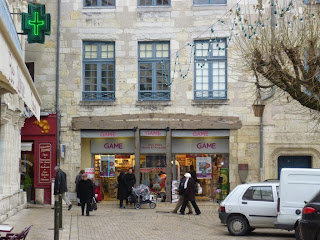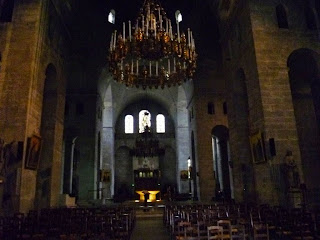Este blog está dedicado a viajes, cosas interesantes, cultura, anécdotas, etc.
domingo, 19 de julio de 2015
19 de Julio de 2015. Desde Vantaa, Finlandia, de hoy mismo.
19 de Julio de 2015. Desde Vantaa, Finlandia, de hoy mismo. Finlandia es el bello país verde del norte de Europa.
_____________________________________________________________________________________________________
July 19th, 2015. From Vantaa, Finland, today. Finland is the beatiful green country of Nort Europe.
lunes, 25 de mayo de 2015
25 de Mayo de 2015. Bayona, Departamento de Pirineos Atlánticos, Región de Aquitania, Francia. Posteando fotos de un viaje anterior.
Bayona, Departamento de Pirineos Atlánticos,
Región de Aquitana, Francia. Situada en la confluencia de los ríos Nive y Adur,
cerca del Mar Cantábrico. Forma parte de la provincia vascofrancesa de Labort,
y de la Región Cultural de Gascuña. Bayona fue fundada el año 950 sobre las
ruinas del castro (campamento) romano Lapurdum.
Existen varias explicaciones sobre el origen de la palabra Bayona. En el
siglo IX fue ocupada por los vikingos, por lo que los habitantes locales
aprendieron los secretos de la construcción de barcos. Fue recuperada por el
Duque de Vasconia un siglo después, y pasó a ser capital del Vizcondado de
Labort. Durante mucho tiempo formó parte del Ducado de Aquitania, y pasó en
1155 a dominación inglesa, desarrollándose
como puerto durante siglos, hasta que Juan de Orleans, Conde de Dunois,
la recuperó para Carlos VII en el último capítulo de la Guerra de los Cien
Años, en 1451. Muchos de los judíos sefardíes expulsados por el decreto de los
Reyes Católicos de España en 31 de Marzo de 1492 se establecieron en Bayona. En
1602 fueron obligados por el rey de Francia a abandonar la ciudad, pero
regresaron en 1789, con la Revolución. A lo largo de los conflictos del siglo
XVII, encontrándose los habitantes de la ciudad cortos de pólvora y balas,
metieron sus cuchillos de caza en el cañón de sus armas, y crearon las bayonetas,
cuchillos que se insertan en la boca de los fusiles. En esta población se firmaron las
abdicaciones, en 1808, de Carlos IV y Fernando VII de España a favor de
Napoleón Bonaparte, hecho jurídico que se conoció como Abdicaciones de Bayona.
El 8 de Julio de ese mismo año se promulgó el Estatuto de Bayona, como
constitución española de José Bonaparte. No es una constitución propiamente
dicha, por ser una carta otorgada. Una constitución es redactada por un cuerpo
legal constituyente de la Nación de la que se trate. El barrio de Saint-Esprit,
situado sobre la orilla derecha del río Adur, se unió a Bayona el 1 de Junio de
1857. Anteriormente era una comuna autónoma del Departamento de Las
Landas. Bayona tiene bonitas atracciones
turísticas, bellos monumentos, y su arquitectura es muy similar a la que
encontramos en España en las ciudades de Pamplona y Bilbao.
Bayonne, Pyrenees Atlantiques Department,
Aquitaine Region, France. Located at the confluence of the Nive and Adour
rivers, near the Bay of Biscay. It is part of the French Basque province of
Labourd, and the Cultural Region of Gascony. Bayonne was founded in 950 on the
ruins of the roman castro (camp) Lapurdum. There are several explanations of
the origin of the word Bayonne. In the ninth century it was occupied by the
Vikings, and so the local people have learned the secrets of shipbuilding. It
was recovered by the Duke of Vasconia a century later, and became capital of
Labort . For a long time it was part of the Duchy of Aquitaine, and went in
1155 to British rule, developed as a port for centuries, until Juan de Orleans,
Count Dunois, recovered it to Charles VII in the last chapter of the Hundred
Years' War in 1451. Many of the Sephardic Jews expelled by the decree of the
Catholic Kings of Spain on March 31, 1492 were established in Bayonne. In 1602
they were forced by the king of France to leave the city, but they returned in
1789 with the Revolution. Throughout the conflicts of the seventeenth century, the
inhabitants of the city found themselves short of gunpowder and bullets, and they
put their hunting knives into the barrel of their guns, and created bayonets,
knives that are inserted into the mouths of guns. In this population the
abdication was signed in 1808 by Charles IV and Ferdinand VII of Spain in favor
of Napoleon Bonaparte, legal fact which became known as Abdications of Bayonne.
On July 8 of that year the statute of Bayonne was promulgated as Spanish
constitution of Joseph Bonaparte. It is not a full-fledged constitution, being
a charter granted. A constitution is drafted by a constituent legal body of the
Nation from which it comes. The Saint-Esprit, located on the right bank of the
Adour river, joined Bayonne on June 1, 1857. Previously it was an autonomous
commune of Landes. Bayona has beautiful tourist attractions, beautiful
monuments attractions, and its architecture is very similar to that found in Spain
in the cities of Pamplona and Bilbao.
miércoles, 20 de mayo de 2015
20 de Mayo de 2015. Périgueux, Departamento de Dordoña, Región Aquitania, Francia. Posteando material de un viaje anterior.
Périgueux,
Departamento de Dordoña, Región de Aquitania. El nombre viene de Petrocorii,
forma latinizada del nombre celta que significaba “cuatro tribus”. Era el
pueblo galo que vivía en la región antes de la llegada de los romanos. Forma
parte del Camino de Santiago en la Vía Lemovicensis. Périgueux es una capital
turística y cultural etiquetada con 4 flores, según los criterios turísticos
franceses. La villa ofrece a los visitantes un patrimonio histórico
galo-romano, medieval y del Renacimiento. La Cité, parte amurallada del casco
histórico, tiene su origen en el siglo I a.c., durante la ocupación romana en
la Galia. La ciudad nace en 1240 de la unión entre La Cité y el
Puy-Saint-Front. Périgueux es la base de empleo de la zona, y abriga alguna
empresa de la SNCF con 700 empleados.
Périgueux,
Dordogne, Aquitaine Region. The name comes from Petrocorii, Latinized form of
the Celtic name meaning "four tribes". It was the French people who
lived in the region before the arrival of the Romans. It is part of the Camino
de Santiago in the Via Lemovicensis. Périgueux is a tourist and cultural
capital labeled 4 flowers, according to the French tourist criteria. The town
offers visitors a Gallo-Roman, medieval and Renaissance heritage. La Cité, the
historic walled town has its origin in the first century BC, during the Roman
occupation of Gaul. The city was born in 1240 from the union between La Cité
and the Puy-Saint-Front. Périgueux is the employment base in the area, and it
is home to some of the SNCF company with 700 employees.
Suscribirse a:
Comentarios (Atom)



















































